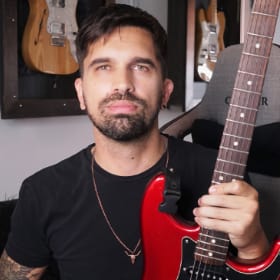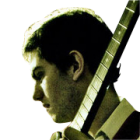More
- Piazzolla RhythmLEVEL 3We'll work with the classical rhythm of Astor Piazzolla music.
- Tango Metal Inspired By PiazzollaLEVEL 5With influences from Astor Piazzolla this lesson features alternate picking, vibratos and bends.
- Mudvayne Style LessonLEVEL 4This band was formed in the mid 90's and it's guitar player is Greg Tribbett.
- AFI Style LessonLEVEL 4This lesson is inspired by the brilliant song "The Leaving Song Part 2".
- Santana Style LessonLEVEL 4Famous Santana style licks with detailed explanations
- Paramore Style LessonLEVEL 4Influenced by the song "Misery business". This song is very typical of Paramore's style.
- Disturbed Style LessonLEVEL 4This time we'll see some nice new metal style lesson about the band Disturbed.
- Meshuggah Style LessonLEVEL 5Dedicated to the style of one of the most cool bands of the prog-death or math-death: MESHUGGAH.
- Oasis Style LessonLEVEL 2This lesson is inspired by the brilliant and successful song Wonderwall.
Feedback
Emilio Perez1st December 2008
Great lesson! I love polyphonic!!
 Toni Suominen1st December 2008
Toni Suominen1st December 2008Great stuff Ramiro!

 Carlos Carrillo1st December 2008
Carlos Carrillo1st December 2008great video!!!!!!interesting stuff!! I love Piazzolla!!!!!!!!
 Gerardo Siere1st December 2008
Gerardo Siere1st December 2008Esta excelente Ramiro.
 Ramiro Delforte30th November 2008
Ramiro Delforte30th November 2008Thank you

I'm glad you like it. I could make another lesson in this style if you want. Alejandro Pinero30th November 2008
Alejandro Pinero30th November 2008Very good lesson Ramiro!!
 Hisham Al-Sanea30th November 2008
Hisham Al-Sanea30th November 2008very nice & cool style Ramiro.
 Lian Gerbino30th November 2008
Lian Gerbino30th November 2008just one word: AMANZING!

 Emir Hot30th November 2008
Emir Hot30th November 2008very cool
 Dejan Farkas30th November 2008
Dejan Farkas30th November 2008Great lesson, I love the counterpoint

 Gabriel Leopardi30th November 2008
Gabriel Leopardi30th November 2008Great lesson Ramiro! Everybody should check Piazzolla's awesome music. (However I know there are many of you that checked it earlier).
 Vinod Saranga30th November 2008
Vinod Saranga30th November 2008Cool tune and video !
good Job Ramiro
 Nazgul30th November 2008
Nazgul30th November 2008This is interesting stuff, Ramiro!

 Jose Mena30th November 2008
Jose Mena30th November 2008Awesome, the next instructor collab should be something like this, and Ramiro should lead it
 Bogdan Radovic30th November 2008
Bogdan Radovic30th November 2008This was so cool ! Great job Ramiro!

 Ivan Milenkovic30th November 2008
Ivan Milenkovic30th November 2008Nice polyphonic tune mate, great job

 Kuba Szafran30th November 2008
Kuba Szafran30th November 2008Great harmonies, sounds really cool Ramiro:)!
- Total views: 0
- Member views: 0
- Guest views: 0
- Lesson
- My notes
Hi GMC! In this lesson I bring to you a little composition that I've made to show the kind of counterpoint that Piazzolla uses. Compositions like "Fuga y Misterio" (Fugue & Mystery) have the particularity that they are composed with counterpoint procedures like the Fugue.
If you listen to a Bach fugue you will notice that it has a counterpoint imitation. The first line enters and after a few measures (maybe less) the second voice enters imitating the first one. The fugue could have many parts (a part is a voice, each voice that enters imitating we call it "a part"). Some fugues reach five or six parts.
This lesson is not about composing a fugue but a fugued kind of counterpoint. The fugue has many rules that we don't apply here. Piazzolla used to take compositional techniques from classical music and employ them into his own music, Tango. This kind of mixture was one of the elements that made him very unique and popular, also revolutionary in Argentinian Tango.
The whole composition is in Am.
I hope you enjoy the lesson!


Jump to start: Home or `s` , you can also click/tap the lesson part again (the numbers above player)
Go to next part: PageUP or End.
Volume: ArrowUp / ArrowDown keys
Go to any part: Number keys (combinations also possible)
Pause or play: `k` or space key
Fullscreen: `f`, esc to close
Increase / decrease speed : `+` or `-`







